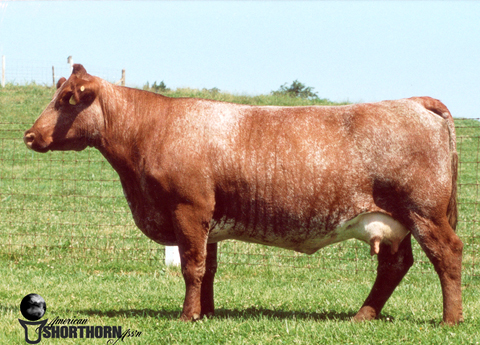
From the Oklahoma Agriculture Breeds website:
“The Shorthorn Breed of Cattle originated on the northeastern coast of England in the counties of Northcumberland, Durham, York, and Lincoln. These counties all touch the North Sea and lie between the Cheviot Hills and the middle part of England. The first real development of the Shorthorn breed took place in the valley of the Tees River. This river, the valley of which is so well known in the development of the breed, lies between Durham and York counties, and the large cattle that inhabited this fertile valley early became known as Teeswater cattle. In addition to having acquired a reputation for producing excellent cattle, the Tees River Valley excelled in crops, pastures, and generally high plane of agriculture.
“As early as 1580 there existed a race of superior short-horned cattle on the Yorkshire estates of the earls and dukes of Northcumberland. The coat color of these cattle varied, but among the colors found were light dun, yellow, yellowish red, deep red, red and white patched, white, and roans.
“It was not until after 1750 that accurate records of consequence were kept of the cattle of the area or of the breeding practices that were followed. Between 1730 and 1780 many eminent breeders had distinguished themselves in their home localities for cattle of improved type and quality…..
“The Colling Brothers. The Colling brothers, Charles and Robert, are often referred to as the founders of the Shorthorn breed of cattle. Other men had previously contributed to the native cattle of the area, but it remained for these two enterprising breeders to develop the first systematic breeding program. Charles Colling resided at Ketton, about four miles northeast of Darlington, in the country of Durham. Darlington had obtained considerable publicity as a market place or “fair” for cattle. Robert Colling settled at Barmpton, which was about a mile closer to the town of Darlington. It was on these two farms that the foundation of the breed was largely laid. About 1783 the Collings visited the home of Bakewell and made a study of his breeding methods.
“Mr. Robert Colling reared a free-martin heifer that became famous by the name “The White Heifer that Traveled.” This nonbreeder was sired by Favorite (252) and attained a live weight of 2,300 pounds. The publicity that was accorded the “Durham Ox” and “The White Heifer that Traveled” did much to advertise the new breed of Shorthorn cattle that was just being formally founded.”
And from Cattle.com
“The Shorthorn was imported to the US in 1873. They were the first purebred cattle recorded to have been used in the improvement of the Texas Longhorn. The notable improvements made by this cross, were such that it became highly popular. Heavy importation of the Shorthorn followed as a direct result. The American Shorthorn Association was established in 1872. It currently holds over 6000 junior and senior members and receives more than 20,000 registries a year.
“The Shorthorn possesses a moderate frame with a rectangular low set body. It can be red, white, roan or a red and white mixed color. Cows are economical assets having high fertility rates, early maturation, sufficient milk, and being overall good mothers. Shorthorns are known to mostly calve easily and be mild tempered cattle. The Shorthorn brings with it high marbling traits and the ability to cross well with just about anything; Red Angus, Maine-Anjou and Herefords make good hybrids. It has been a key contributor for the development of the Santa Gertrudis.
“The Shorthorn is currently plagued by the presence of TH in a relatively contained but popular bloodline. It is important to bear in mind that this is not a genetic defect exclusive to the Shorthorn. The lethal genetic defect, Tibial Hemimelia is evident in newborn cattle that are born with twisted legs with fused joints, have large abdominal hernias and a skull deformity. They typically don’t survive calving but must be destroyed if they do.
“The efforts of the American Shorthorn Association began in 1999, when the first affected calves were provided for research. In November of 2003 the ASA Genetic Defect Protocol was approved providing guidelines for reporting affected calves or submitting them for testing. The same policy was amended in August 2005, this time with policy requirements on breeding animals. As of the first of 2006, all AI bulls, donor dams and cloned animals were required to be DNA genotyped, parentally verified and be tested for genetic defects. The ASA issued registration certificates regardless of genetic test results, but would maintain a record of who tested free of defect or was in deed a carrier.”
You can get more information at the American Shorthorn Association website by clicking HERE.
If you have problems seeing the video below click HERE
.youtube::o2oMmhUhDmU::
